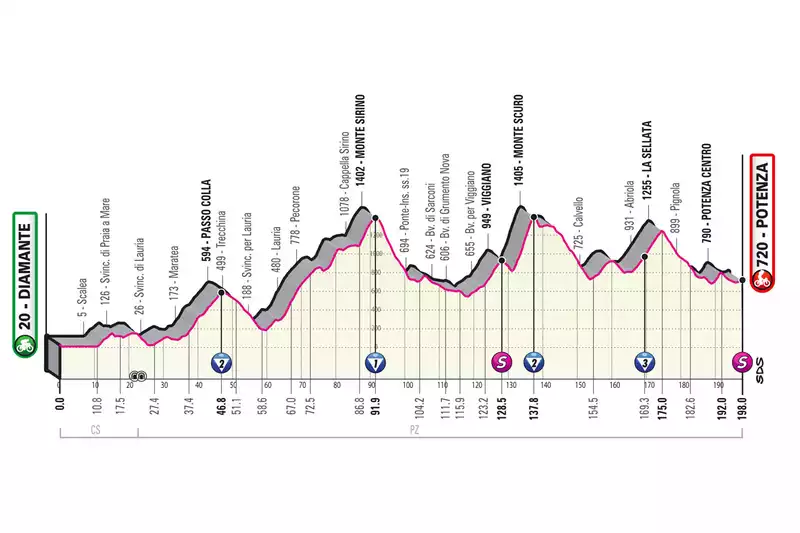Six stages of the 2022 Giro d'Italia have been announced as RCS Sport continues to announce next year's route.
After the sprint details were announced on Monday, the six hilly stages were outlined on Tuesday.
As with the sprint stages, RCS Sport announced the details of the hilly stages without specifying exactly where they would be located on the route. Therefore, the full picture of this year's Giro will only be revealed near the end of the lengthy route announcement.
On Tuesday, RCS Sport confirmed that Naples will return to the Giro route for the first time since hosting the Grande Partenza in 2013.
The 2022 Giro has already been confirmed to start in Budapest on May 6 and will also feature at least two stages in Sicily before reaching mainland Italy on a flat leg from Palmi to Scalea.
The hilly stage from Diamante to Potenza will likely be the seventh stage of the 2022 edition. This stage, which is 198 km long with 4,490 m of climbing, is rated 4-star difficulty by RCS Sport. The route winds through the mountains of Calabria and Basilicata, similar to the stage won by Filippo Ganna at the 2020 Giro Camigliatello Srano.
Monte Sirino had three stage finishes in the 1990s, with Lauderino Cubino winning in 1995, Davide Rebellin a year later, and Chepe Gonzalez beating a young Danilo di Luca in 1999.
Stage 8, which returns to Naples for the first time in nine years, will probably soon bring the next hilly day in the south.
The 149-km stage starts and finishes in Naples, but leaves the city for a short but steep climb up Monte di Procida for five laps around the 19-km circuit of Campi Flegrei, a volcanic area west of Naples. The race returns to Naples for the finale, finishing by the sea on Via Caracciolo, just as Mark Cavendish did when he won his first maglia rosa in the 2013 Giro.
The early part of the second week of the Giro will feature a hilly stage in the Marche region from Pescara to Jesi.
The 194-km stage is a one- and two-day half stage. After a flat early stage along the coast, the terrain becomes more rugged as the riders reach Civitanova Marche. A Category 4 climb continues up to Sant'Ignazio di Montelpone and a similar climb to Recanati, the birthplace of poet Giacomo Leopardi.
The route then passes through Filotrano, the home town of Michele Scarponi (deceased), before a Category 4 climb in Monsano before finishing in Gesi. Like the Tirreno-Adriatico, the uncategorized Murri around Jessi could be a decisive climb, as well as a categorized climb.
The second half of the second week offers two stages with the possibility of escapes, including a 186 km, 2840 m climb from Parma to Genoa.
The early stages to Passo del Bocco, where Wouter Weylandt was tragically killed in the 2011 Giro, are gently uphill. After a descent to Chiavari, the route continues via Chiesa Vecchia to the Category 3 Ruta. After the climb, a plateau leads to Monte Fasse and then a steep descent to the finish in Genoa.
While the flat stage to Cuneo has already been decided, RCS Sport has released an overview of the second hilly stage in Piedmont, from Sant'Anena to Turin, which packs some 3,470 meters of climbing into just 153 km. The stage will consist of two and a half laps around a circuit that includes the Colle della Maddalena, Sperga, and Roccia Santa Brigida, finishing on the banks of the Po River.
Meanwhile, week 3 of the Giro will take place in Friuli in northeastern Italy with the Mt. Nakayama stage from Marano Lagnale to Santuario di Castelmonte. This stage climbs the Tanamea Pass, then temporarily heads to Slovenia, where it climbs the Category 1 Monte Colovrat. It is 10 km long with a gradient of nearly 10%.
After returning to Italy, the riders will pass through Cividale del Friuli and then climb a Category 2 climb overlooking Castelmonte. The total length is 178 km and the climbing distance is about 3230 m.
.

Comments